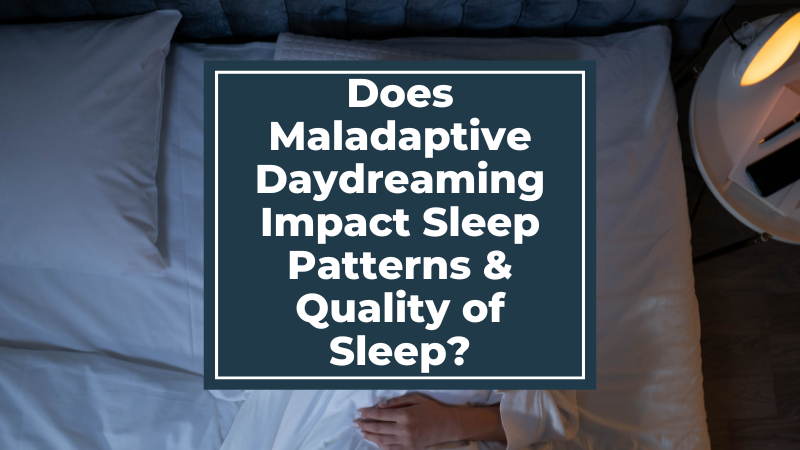As anyone who has suffered from maladaptive daydreaming can probably tell you, yes, yes it does.
Maladaptive daydreaming, a psychological phenomenon characterized by excessive and immersive daydreaming, can have profound effects on various aspects of an individual’s life, including sleep. For those who experience maladaptive daydreaming, the boundary between fantasy and reality becomes blurred, often leading to a significant impact on sleep patterns and quality. The intense engagement in daydreaming can disrupt sleep architecture, contribute to sleep-related anxieties, and lead to daytime fatigue and impairment.
For me, one of the obvious ways maladaptive daydreaming affected my sleep was obvious because I would put off sleeping until as late as possible so that I could spend more time daydreaming, and then I would also wake up as early as possible so that I could get back to it. I’ve functioned on very little sleep for most of my life, but the effects of maladaptive daydreaming are a lot more complex than that. In fact, there are a lot of different ways maladaptive daydreaming can affect sleep, and it might not be the same for everyone.
Understanding how maladaptive daydreaming affects sleep is crucial for developing effective management strategies and promoting restful sleep. In this article, we will explore the ways in which maladaptive daydreaming can impact sleep and discuss practical tips for improving sleep quality while managing this condition.
How Maladaptive Daydreaming Affects Sleep
Maladaptive daydreaming can have a significant impact on sleep patterns and the quality of sleep experienced by individuals. Here are some ways in which maladaptive daydreaming can influence sleep:
- Sleep Disturbances: Engaging in excessive daydreaming, particularly during nighttime, can disrupt the natural sleep-wake cycle. The preoccupation with daydreaming may result in difficulty falling asleep, maintaining sleep, or experiencing fragmented sleep patterns.
- Sleep Onset Delay: Individuals with maladaptive daydreaming may find it challenging to transition from their daydreaming state to a relaxed and calm state conducive to sleep. The vivid and engaging nature of daydreams can make it difficult to quiet the mind and achieve a peaceful sleep onset.
- Intrusive Thoughts: Maladaptive daydreamers may experience intrusive thoughts or intense daydreaming episodes during bedtime, leading to increased cognitive arousal and difficulty winding down for sleep. These intrusive thoughts can occupy the mind, making it harder to relax and enter a restful sleep state.
- Sleep Deprivation: Spending excessive time engaged in daydreaming can interfere with regular sleep patterns, resulting in inadequate sleep duration and overall sleep deprivation. Chronic sleep deprivation can have negative consequences on physical and mental health, including impaired cognitive functioning and increased risk of various health conditions.
- Daytime Sleepiness and Fatigue: Insufficient or disrupted sleep caused by maladaptive daydreaming can lead to daytime sleepiness, reduced alertness, and fatigue. Individuals may find it challenging to concentrate, perform daily tasks, or maintain optimal productivity due to the lingering effects of poor sleep quality.
- Sleep Anxiety: Maladaptive daydreaming can trigger anxiety, especially when individuals become preoccupied with their daydreams instead of focusing on sleep. This anxiety can make it challenging to relax and fall asleep, leading to prolonged periods of wakefulness and heightened arousal.
- Sleep-Related Parasomnias: Some individuals with maladaptive daydreaming may experience sleep-related parasomnias, which are abnormal behaviors or experiences during sleep. This can include sleep talking, sleepwalking, or vivid dreams that overlap with their daydreaming episodes.
- Sleep Fragmentation: The intense engagement in daydreaming can disrupt the natural sleep cycle, causing frequent awakenings during the night. These interruptions in sleep continuity can result in fragmented sleep, leaving individuals feeling unrested and fatigued upon waking.
- Emotional Regulation during Sleep: Maladaptive daydreaming often serves as a means of emotional regulation, allowing individuals to escape or cope with underlying emotional distress. Without the opportunity to engage in daydreaming during sleep, individuals may find it challenging to regulate their emotions during the night, potentially leading to heightened emotional arousal and disrupted sleep.
- Sleep-Related Cognitions: Maladaptive daydreaming can result in excessive rumination or preoccupation with daydreams, even during sleep. Individuals may find themselves continuing their daydreams or experiencing dream-like scenarios while asleep, which can disrupt the normal sleep process and reduce the overall quality of sleep.
- Increased Time Awake in Bed: Individuals with maladaptive daydreaming may spend extended periods awake in bed due to their engagement in daydreaming. This can result in a decreased association between the bed and sleep, making it more challenging to establish a consistent sleep routine and maintain good sleep hygiene.
- Escapism from Sleep Problems: For some individuals, maladaptive daydreaming may serve as a means of escape or avoidance from underlying sleep problems such as insomnia or nightmares. Rather than addressing and resolving the underlying sleep issues, individuals may resort to excessive daydreaming as a coping mechanism, which can perpetuate the cycle of poor sleep.
- Impact on Sleep Hygiene: Engaging in maladaptive daydreaming can disrupt established sleep hygiene practices, such as maintaining a consistent sleep schedule, avoiding stimulating activities before bed, and creating a calm sleep environment. The focus on daydreaming can lead to neglecting these essential sleep-promoting habits, further exacerbating sleep difficulties.
- Sleep-Wake Schedule Disruptions: Maladaptive daydreaming can disrupt the regular sleep-wake schedule, leading to irregular bedtimes and wake times. Inconsistent sleep patterns can further contribute to sleep difficulties, as the body’s internal clock becomes disrupted.
- Impact on Sleep Architecture: Maladaptive daydreaming can affect the various stages of sleep, including rapid eye movement (REM) sleep and non-rapid eye movement (NREM) sleep. Disruptions in sleep architecture can result in a less restorative and refreshing sleep experience.
- Sleep-Related Fear: Some individuals with maladaptive daydreaming may develop anxiety or fear associated with sleep due to the negative impact it has on their daydreaming patterns. This can create a vicious cycle where anxiety about sleep further exacerbates sleep difficulties.
It is important to note that the relationship between maladaptive daydreaming and sleep can be complex and multifaceted, varying among individuals. Sleep disturbances may contribute to the perpetuation of maladaptive daydreaming, creating a cycle of disrupted sleep and excessive daydreaming.
What Are Some Ways I Can Try to Improve My Sleep Quality?
Improving sleep quality when dealing with maladaptive daydreaming requires a multifaceted approach that addresses both the underlying causes of excessive daydreaming and promotes healthy sleep habits. Much of the advice for improving sleep when you believe maladaptive daydreaming is contributing to its poor quality is similar to the general advice about getting a better night’s sleep, with an emphasis on mind-calming techniques. Here are some strategies that can help:
- Establish a Consistent Sleep Schedule: Set regular bedtimes and wake-up times to regulate your body’s internal clock. Consistency in sleep timing can help promote better sleep quality.
- Create a Relaxing Bedtime Routine: Develop a relaxing routine before bed to signal to your body that it’s time to wind down. This may include activities like reading a book, taking a warm bath, practicing relaxation techniques, or listening to calming music.
- Create a Sleep-Friendly Environment: Make your bedroom conducive to sleep by ensuring it is dark, quiet, and at a comfortable temperature. Use comfortable bedding and invest in a supportive mattress and pillows. Avoid heavy meals and excessive fluids close to bedtime, and avoid napping during the day if it interferes with nighttime sleep.
- Limit Stimulating Activities Before Bed: Avoid engaging in stimulating activities, such as using electronic devices or watching intense TV shows, in the hour leading up to bedtime. The blue light emitted by screens can disrupt sleep patterns.
- Practice Relaxation Techniques: Incorporate relaxation techniques into your daily routine, such as deep breathing exercises, meditation, or progressive muscle relaxation. These techniques can help calm the mind and prepare your body for sleep.
- Manage Stress: Find healthy ways to manage stress during the day, as stress can exacerbate maladaptive daydreaming and disrupt sleep. Engage in activities like exercise, journaling, or talking to a trusted friend or therapist to help reduce stress levels.
- Seek Professional Help: Consider working with a therapist or mental health professional who specializes in maladaptive daydreaming or related conditions. They can provide guidance, support, and evidence-based interventions to help you manage your daydreaming tendencies and improve sleep quality.
- Engage in Regular Physical Activity: Regular exercise can help regulate your sleep-wake cycle and promote better sleep. Aim for at least 30 minutes of moderate-intensity exercise most days of the week, but avoid exercising too close to bedtime.
- Limit Caffeine and Stimulant Intake: Reduce or avoid consuming caffeine and stimulants, such as coffee, tea, energy drinks, and certain medications, especially in the afternoon and evening. These substances can interfere with your ability to fall asleep and stay asleep.
- Practice Mindfulness: Incorporate mindfulness techniques into your daily routine to cultivate present-moment awareness. Mindfulness can help you become more grounded and reduce the tendency to escape into daydreaming. Consider mindfulness meditation, yoga, or other mindfulness practices.
- Consider Cognitive-Behavioral Therapy (CBT): CBT is a therapeutic approach that can help individuals with maladaptive daydreaming by addressing underlying thoughts, emotions, and behaviors. It can provide tools to manage excessive daydreaming and promote healthier sleep patterns.
- Create Boundaries with Daydreaming: Set boundaries for yourself when it comes to daydreaming. Designate specific times and places for daydreaming, such as during breaks or designated “daydreaming sessions,” and make a conscious effort to limit daydreaming during other times, especially close to bedtime.
- Stay Consistent and Patient: Changing sleep habits takes time and consistency. Be patient with yourself as you work towards improving sleep quality. It may take some trial and error to find the strategies that work best for you, so be open to trying different approaches and adjusting as needed.
Remember that everyone’s experience with maladaptive daydreaming is unique, and finding the right strategies may involve some trial and error. Be patient and persistent, and don’t hesitate to seek professional help if needed. By implementing these strategies and making sleep a priority, you can take steps toward improving sleep quality and overall well-being.
In Conclusion: The Effect of Maladaptive Daydreaming On Your Sleep
Recognizing the impact of maladaptive daydreaming on sleep is essential for individuals seeking to regain control over their sleep patterns and overall well-being. By understanding how maladaptive daydreaming affects sleep quality and implementing effective strategies, individuals can work towards improving their sleep hygiene and establishing healthier sleep routines.
In my personal experience, not all of these negative sleeping factors will go away even if you are able to end maladaptive daydreaming. These sleep problems can exist outside of your maladaptive daydreaming and may require a whole different approach and treatment. I still struggle with poor sleep even though I have not maladaptive daydreamed for several years now.
Seeking professional support, such as therapy or counseling, can also be beneficial in addressing the underlying causes of maladaptive daydreaming and developing coping mechanisms to promote better sleep. With a comprehensive approach that addresses both maladaptive daydreaming and sleep disturbances, individuals can take positive steps toward achieving restorative sleep and enhancing their overall quality of life.









